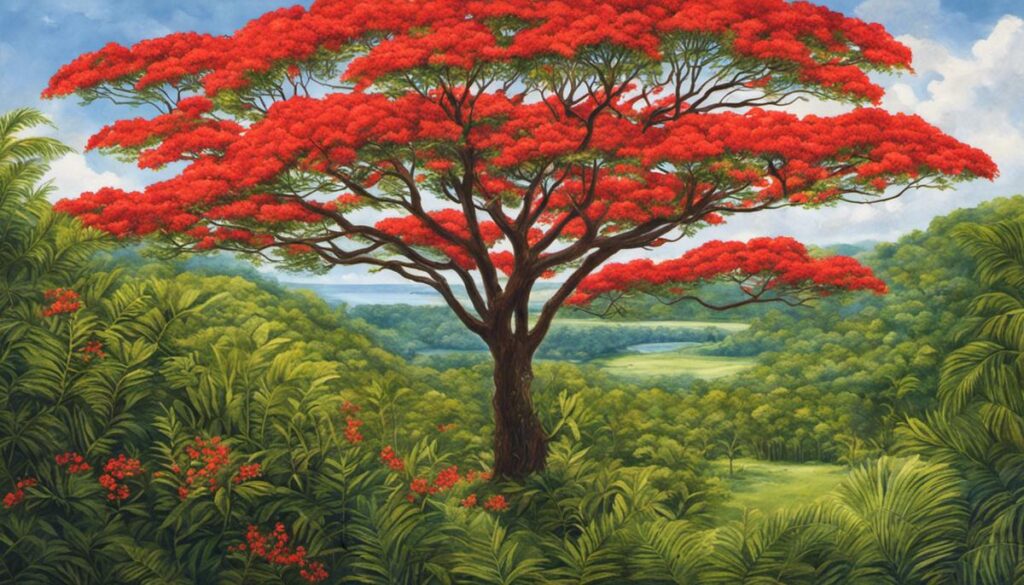Imagine a tree, resplendent with fiery red flowers, maintaining a fortitude that stands against the winds of change, and yet condenses the majesty of its full size into a relic small enough to be held in a pot. This is the intrigue of the Royal Poinciana Bonsai, a tree steeped in rich origins and fascinating cultivation methods that we will delve into.
The splendor of the Royal Poinciana, originally found in regions of Madagascar, has been captured in the art of bonsai, introducing this glorious arboreal beauty to homes and gardens around the globe. As we chart the journey from seed to bonsai, we’ll explore the vital elements of care, from unique planting techniques and optimal growing conditions to maintenance, problem-solving and appreciation of these miniature wonders.
Origins of Royal Poinciana Tree
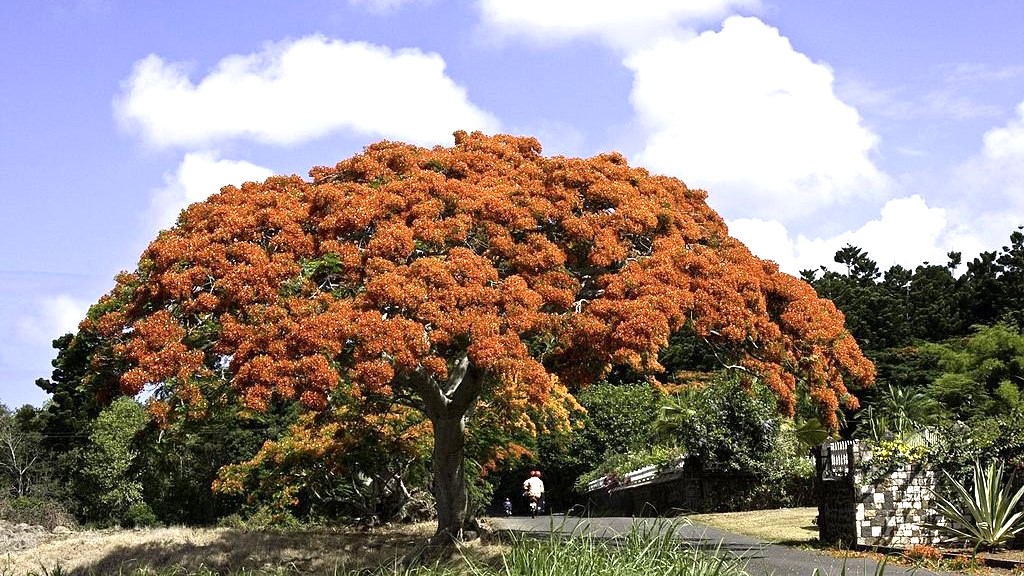
Royal Poinciana Tree: A Historical Perspective
The Royal Poinciana tree, scientifically known as Delonix regia, is believed to have its origins in Madagascar, though it’s now found in various tropical regions around the world. Revered for its flamboyant display of vibrant red and orange flowers, the Royal Poinciana is often referred to as the “Flame Tree.”
The tree thrives best in a tropical or near-tropical climate and is classified as a subtropical plant in scientific terms. Some studies also suggest that it was first introduced in the United States in the mid 19th century. It’s commonly found in parts of Florida, Texas, and Southern California.
Royal Poinciana Bonsai: A Unique Conversation Piece
The Royal Poinciana tree is favored by bonsai enthusiasts for its striking appearance and unique features. The tree has a broad, umbrella-like canopy that provides shade and beauty. Its compound leaves comprise little leaflets, which create an overall feathery look. This characteristic is particularly treasured in a bonsai as it can mimic larger trees while within a small pot.
Bonsai enthusiasts also appreciate the Royal Poinciana for its speedy growth and relative ease of maintenance, considering it’s a tropical plant. Even though the tree can grow to considerable heights in nature, it responds well to pruning and shaping, vital practices in bonsai culture.
Cultivation and Care: Keeping a Poinciana Bonsai Thriving
When used for bonsai, the Royal Poinciana requires a good deal of light, heat, and moisture to thrive. However, it is drought-resistant and can handle occasional dry periods. Keeping these factors balanced makes it especially suited for indoor cultivation as a bonsai.
Winter care is critical since the Royal Poinciana doesn’t tolerate frost well. In cold climates, it should be overwintered indoors to defend against frost damage.
Annual repotting or root pruning in the spring season is recommended, as bonsais are generally kept in constrained pots, and Royal Poinciana is a fast grower. Also, regular watering is critical, ensuring the soil stays evenly moist but not waterlogged. For the sake of its overall wellbeing, Poinciana should be placed in a location where it can get abundant sunlight.
Artistic Significance: Beyond just Aesthetics
While the Royal Poinciana serves as an incredibly attractive bonsai due to its stunning looks, it’s also reputed for its cultural value across different nations. In Vietnam, it is referred to as the “Phoenix’s Tail”, symbolizing the love of a student. Meanwhile, within the Caribbean islands, it’s frequently mentioned in literary pieces representing flamboyance and vibrancy, mirroring its own remarkable blossom presentation.

Growing Royal Poinciana Bonsai
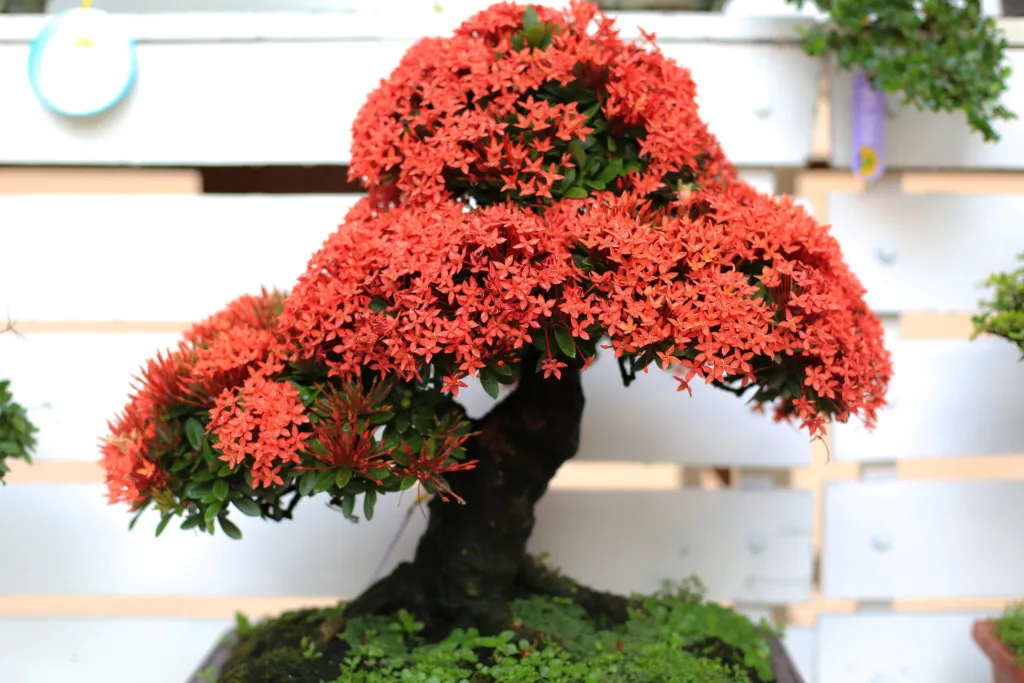
Commencing Your Journey: Choosing a Sapling or Seeds
As you embark on your journey to grow a Royal Poinciana bonsai, your initial step would be to choose between starting from a seed or a sapling. When beginning with seeds, prioritize selecting those that are clean and healthy. You can obtain these Royal Poinciana seeds through online platforms or botanical garden stores. On the other hand, choosing a sapling from a nursery can give you a more youthful and lively tree to start with.
Requisite Soil and Pot Preparation
Regardless of whether you use a seed or a sapling, the next step is to prepare your bonsai pot. For Royal Poinciana, a pot width between 12 to 18 inches is recommended. This allows ample space for root expansion and pot stability. A bonsai soil mix, which is typically fast draining and nutrient balanced, is crucial. A popular mix consists of Akadama, Pumice, and Lava rock (1:1:1 ratio), this ensures good drainage and breathability for the tree roots. Also, a wire mesh bottom restrains the soil from washing away but permits water to pass.
Planting Bonsai-Style and Care
When planting a Royal Poinciana tree as a bonsai, it’s essential to follow established bonsai techniques. This includes shaping the tree using wire or string and regularly pruning to maintain a size-appropriate to the pot. Royal Poinciana bonsai trees do not tolerate heavy pruning well, so it is best to prune carefully and not too frequently. Wiring can be done throughout the year as the branches are quite flexible, but it’s best to remove the wires during the growth period as the branches thicken quickly.
Optimal Growing Conditions
To succeed in growing a Royal Poinciana bonsai, it’s important to provide optimal growing conditions. These include ample sunshine and warm temperatures. The Royal Poinciana is known as a sun lover; therefore, it requires at least six hours of sunlight per day. Ideal locations include sunny windowsills or terraces.
Temperature-wise, Royal Poinciana thrives in warm temperatures above 50° Fahrenheit (10° Celsius), it’s sensitive to frost and should be protected during freezing weather. Remember to water regularly, allowing the soil to dry out slightly between waterings.
Nutrition and Maintenance
Like all bonsais, Royal Poinciana needs regular fertilizing to ensure it has all the nutrients it needs to maintain healthy growth. An organic fertilizer should be applied during the growing season (spring to early autumn) every two weeks. Keep in mind that over-fertilizing may lead to unnecessarily vigorous growth that is difficult to control.
Maintenance also includes regular pest checks. Royal Poinciana may fall victim to spider mites and scale insects. Another threat is root rot, often caused by overwatering.
Conclusion
Indeed, cultivating a Royal Poinciana bonsai involves achieving a careful balance of appropriate conditions, consistent care, nurturing, and exercises of patience. By diligently adhering to these instructions, you can cultivate a thriving Royal Poinciana bonsai.
Caring for Royal Poinciana Bonsai

Unfolding the Mysterious Royal Poinciana Bonsai
Recognized by vivid names such as flamboyant, flame tree, or by its scientific name Delonix regia, the royal poinciana bonsai is a fast-growing, deciduous tree originally from the lands of Madagascar. The charm of this bonsai tree lies in its distinctive umbrella-like canopy, its bright, fiery red flowers, its intricate fern-like foliage, and a wide, twisted trunk. The nurturing of a royal poinciana bonsai demands commitment and knowledge as the tree has particular needs to sustain its health and ensure its long-lived existence.
Watering Your Royal Poinciana Bonsai
The royal poinciana bonsai needs plenty of water, especially during its growing season from late spring to early fall. It is during this season that your bonsai will be making new leaves and flowers, requiring extra hydration. For best results, water your bonsai thoroughly when the top 1-2 inches of soil becomes dry. Make sure not to overwater your tree as this can lead to root rot and other diseases. During winter months, reduce watering frequency as the tree will be dormant.
Fertilizing Your Bonsai
Nutrient-rich soil is key to the health of your royal poinciana bonsai. However, even the best soil will require additional feeding to keep this fast-growing tree healthy. Choose a balanced, slow-release bonsai fertilizer, applying it per package instructions, typically every two weeks during the growing season. This will ensure your royal poinciana has the nourishment it needs to thrive.
Pruning and Shaping the Royal Poinciana Bonsai
The royal poinciana bonsai is a fast-growing species, making regular pruning necessary to maintain its miniature size and desired shape. Pruning is best done during the growing season when the tree can rebound quickly. Make sure to use sharp, clean bonsai shears to ensure clean cuts and prevent infection. To aid in trimming, wiring can be used to subtly guide branches into desired positions, but it must be done carefully to prevent damage.
Repotting Your Royal Poinciana Bonsai
Bonsai trees require regular repotting to ensure they have room to grow and maintain their health. The royal poinciana bonsai typically needs repotting every two to three years, although this frequency can vary based on the size and age of your tree. The best time to repot your bonsai is during late winter or early spring, just before the start of the growing season. Remember to prune back the roots during the repotting process.
Understanding Pests and Diseases
Like any plant, the royal poinciana bonsai can be susceptible to pests and diseases. Regular observation of your bonsai will help identify any potential issues early. Common pests include mealybugs, aphids, and spider mites. Fungal infections can also occur, particularly if the tree is overwatered, and leaf spot diseases are common in damp environments. If any signs of infestations or disease appear, treat immediately with an appropriate fungicide or pesticide.
The intricate process of nurturing a royal poinciana bonsai combines daily care with long-term vision. The end result? An awe-inspiring, downsized version of a lofty tropical tree right within the confines of your own home or garden. A meticulously cared for royal poinciana bonsai doesn’t just thrive—it transforms into a center of tranquility, a testament to your patience and a beautiful embodiment of nature’s artistry.

Pest, Diseases, and Troubleshooting
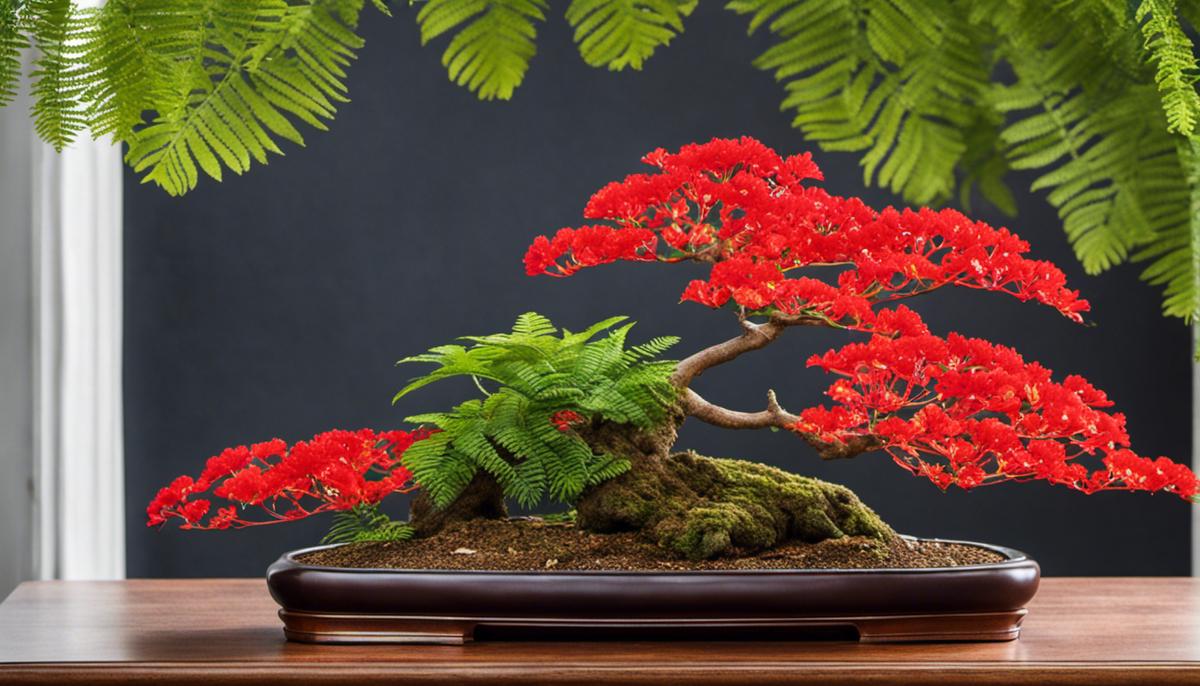
Potential Threats: Pests and Diseases Impacting the Royal Poinciana Bonsai
Even with its robust nature, the Royal Poinciana Bonsai is susceptible to certain pests and diseases that can mar its health and beauty. Foremost among these is the Royal Poinciana caterpillar—an invasive pest known to feast on the plant’s greenery. Aphids, tiny insects notorious for sapping nutrition and causing leaf distortion and yellowing, are another potential menace.
When it comes to diseases, the most common culprits are fungal infections and root rots. Fungal infections typically breach the bonsai through its wounds or weakened points, and manifest as yellowing of the leaves—often a warning sign of disease. On the other hand, root rot, typically a result of overwatering or poor soil drainage, can slow down growth, induce leaf drop, and in dire conditions, even lead to the bonsai’s demise.
Preventive Measures: Thwarting Off Pests and Diseases
To maintain a healthy Royal Poinciana Bonsai and prevent the onset of these conditions, several preventative measures can be taken. Regularly inspecting the tree for pests and signs of disease greatly aids early detection and effective management. Cleanliness can significantly reduce the likelihood of infections. Using clean tools, repotting in fresh soil, and maintaining clean surroundings can help prevent the onset of fungal infections and root rots.
Appropriate watering is essential as both overwatering and underwatering can make the Royal Poinciana Bonsai susceptible to diseases. Striking the right balance provides the tree with the necessary hydration without facilitating conditions for root rot.
Treatment Solutions: Saving the Royal Poinciana Bonsai
If preventive measures fall short and the Royal Poinciana Bonsai contracts a disease or attracts pests, several treatment solutions can help restore the tree’s health. When facing a pest infestation, natural predators can be a plausible solution. Ladybugs and other predatory insects can keep aphid populations in check. For serious infestations, insecticides can be used, with preference given to eco-friendly options.
If fungal infections or root rot are detected, affected areas should be removed immediately to prevent the spread. This could involve pruning away infected branches or, in cases of root rot, removing the bonsai from its pot and cutting away diseased roots. After such pruning, ensure the bonsai is kept in dry conditions until the wounds heal to avoid further infection.
Troubleshooting Common Issues: Yellowing Leaves and Slow Growth
A common issue with the Royal Poinciana Bonsai is yellowing leaves, often an initial indication of a problem. Overwatering, poor drainage leading to waterlogging, inadequate light, or nutrient deficiency are common causes of yellow leaves. Adjusting these environmental factors can help reverse this symptom and ensure the health and growth of the Royal Poinciana Bonsai.
Slow growth, another common issue, can be a result of poor nutrition, inadequate light, or insufficient water. It’s essential to ensure the bonsai is provided with balanced nutrition, sufficient light exposure, and a regular watering schedule to rectify slow growth.
In order to foster a healthy and flourishing Royal Poinciana Bonsai, it’s critical to both grasp the common issues these bonsai trees encounter and establish a regular care regimen concentrated on preemptive and remedial practices.
Bonsai Care Essentials
Displaying and Appreciating Royal Poinciana Bonsai
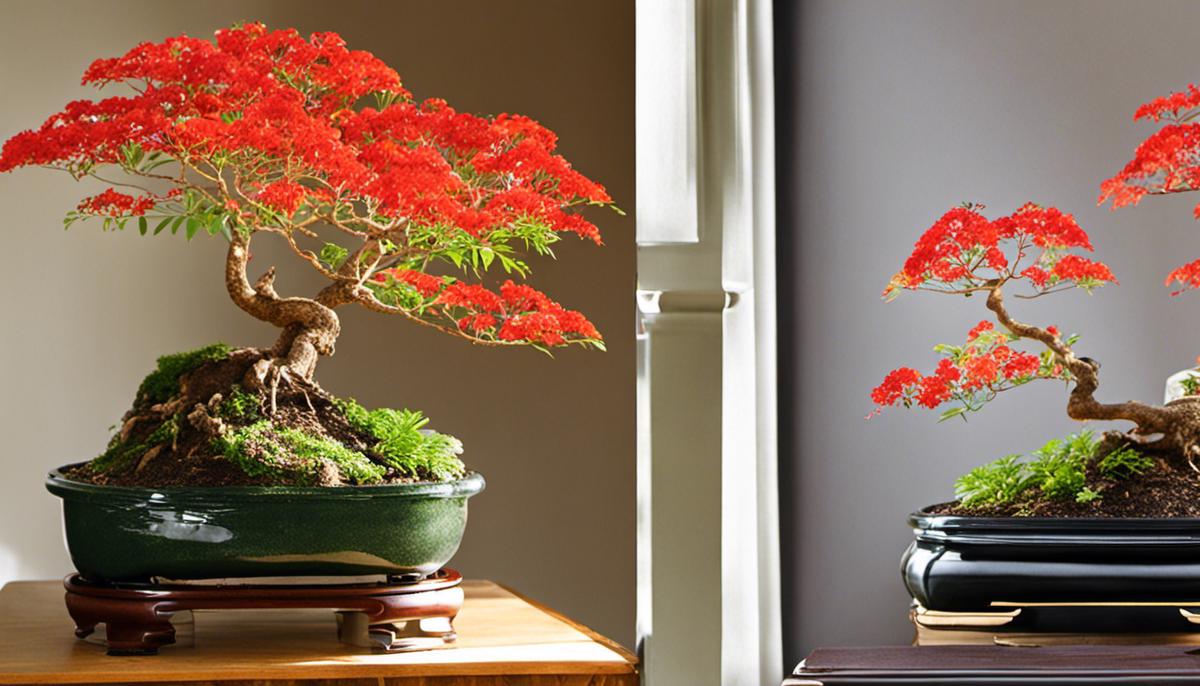
Choosing the Perfect Spot for Your Royal Poinciana Bonsai
Picking out the perfect spot in your house for your royal poinciana bonsai involves considering several key factors. Firstly, these trees prefer bright areas so placing them where they can get plenty of natural sunlight is essential – think south-facing windowsills, for example. Coupled with their love for warmth and their aversion to cold, the indoor setting becomes an even more attractive option for these bonsais. But, take care to avoid locations that are drafty or where sudden temperature drops are possible as these could negatively impact the tree’s health.
Aesthetic Principles: The Artful Appeal
The royal poinciana bonsai exhibits vivid orange-red blossoms in spring and summer, offering a vibrant aesthetic appeal. The plant develops a wide, umbrella-like canopy, creating an artisan presence while requiring a considerable amount of space. Its twisting, gnarly trunk adds to its unique visual appeal. Decoratively, this bonsai can become a centerpiece in any room provided it’s paired with complementary decor elements. Minimalist themes offset its vibrant color and intricate structure nicely, allowing the plant to stand out. Remember, the pot you select needs to be both functional for the tree’s health and artful to enhance its visual appeal.
Cultural Significance: The Flame of the Forest
Known as the ‘Flame of the Forest,’ the royal poinciana originates from Madagascar. It is celebrated in many cultures worldwide for its lush flowery display and is a symbol of flame, immortality, and vibrant life. People in Vietnam see the royal poinciana as a symbol of student life because it flowers during their graduation. Some see the display of a royal poinciana bonsai as a conversation starter about other cultures and a way to visually appreciate the global interconnectedness of our societies.
Bonsai Care: Fostering the Royal Poinciana
To fully appreciate this stunning bonsai, maintaining its health ensures full blooming during the flowering season. Regular yet moderate watering should be exercised, with precautions not to overwater or underwater – the soil should never be soggy or entirely dry. These trees also require frequent pruning and shaping due to their fast growth rate, which allows the owner to personalize the bonsai’s shape. Lastly, regular fertilizing is key to robust growth and the vibrant colors of its flowers. Understanding these necessities will allow you to appreciate the evolving beauty of the royal poinciana bonsai.
Exhibiting: The Stately Presence
Highlighting your royal poinciana bonsai in your home or garden can be done with various techniques. Implementing a circular viewing area to allow 360-degree appreciation of the bonsai can create an artistic and interactive experience. If inside, clean, simplicity near your bonsai will make it the room’s focal point. In a garden context, try juxtaposing smaller, more muted plants nearby to emphasize the royal poinciana’s grandeur. Being mindful of how you display your royal poinciana bonsai can enhance its appreciation and elevate the overall atmosphere of its location.
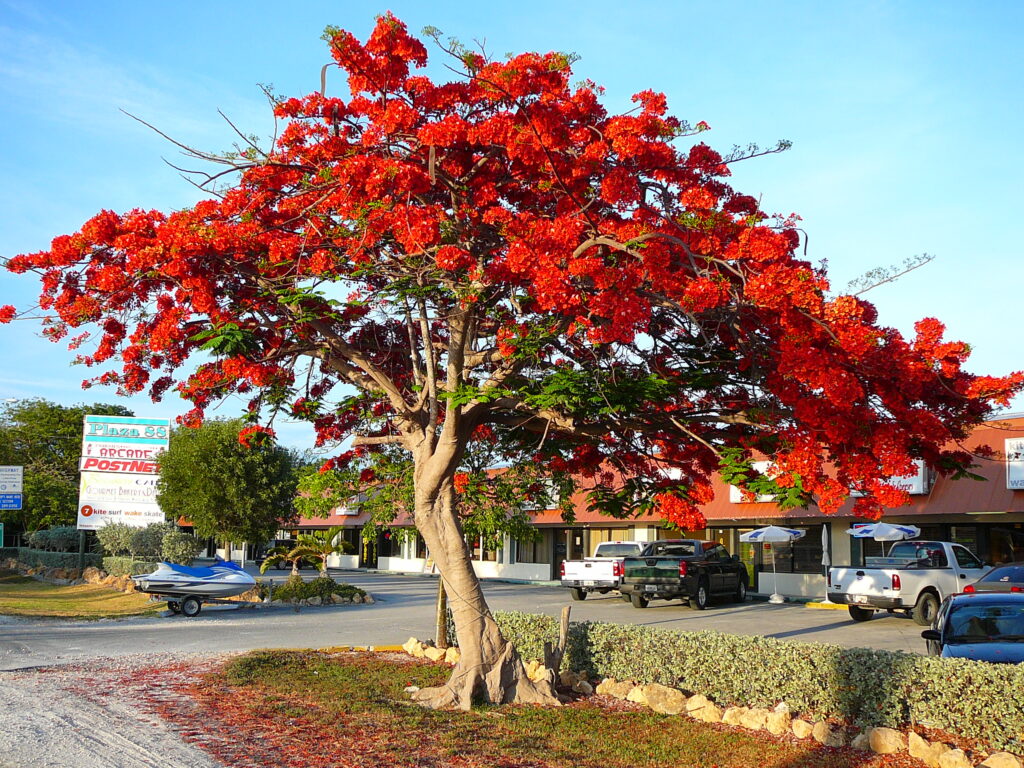
The journey of the Royal Poinciana Bonsai is one of patience, care, and appreciation for nature’s incredible ability to adapt and flourish. The profound beauty of these trees, condensed in scale yet retaining their allure, challenges not only our cultivation skills but also our capacity to appreciate natural artistry. The way these trees reflect cultural significance and personal investment adds an additional layer of intricate charm. Providing preventive and treatment measures for possible pests and diseases, and displaying the bonsai in a way that enhances its inherent elegance, makes owning a Royal Poinciana Bonsai a rewarding and enriching experience. As you care for your bonsai, may you also find a new way to connect with nature and its splendid creations.
